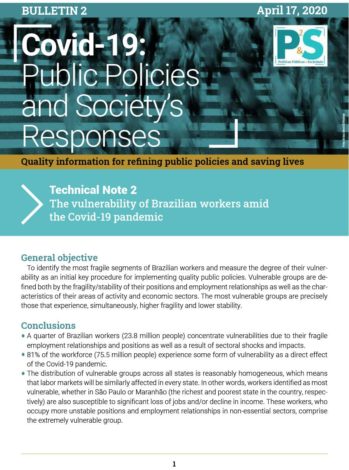General objective
To identify the most fragile segments of Brazilian workers and measure the degree of their vulnerability as an initial key procedure for implementing quality public policies. Vulnerable groups are defined both by the fragility/stability of their positions and employment relationships as well as the characteristics of their areas of activity and economic sectors. The most vulnerable groups are precisely those that experience, simultaneously, higher fragility and lower stability.
Conclusions
- A quarter of Brazilian workers (23.8 million people) concentrate vulnerabilities due to their fragile employment relationships and positions as well as a result of sectoral shocks and impacts.
- 81% of the workforce (75.5 million people) experience some form of vulnerability as a direct effect of the Covid-19 pandemic.
- The distribution of vulnerable groups across all states is reasonably homogeneous, which means that labor markets will be similarly affected in every state. In other words, workers identified as most vulnerable, whether in São Paulo or Maranhão (the richest and poorest state in the country, respectively) are also susceptible to significant loss of jobs and/or decline in income. These workers, who occupy more unstable positions and employment relationships in non-essential sectors, comprise the extremely vulnerable group.
Work group responsible
Coordination: Rogério Jerônimo Barbosa and Ian Prates
Researcher
- Thiago de Oliveira Meireles


